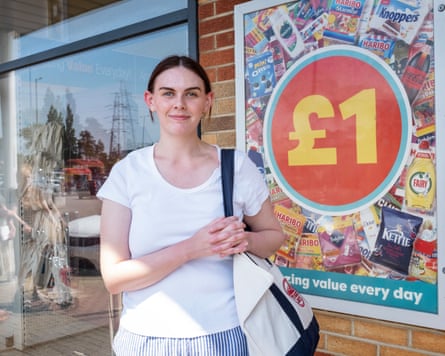“It’s not actually that cheap any more. It’s kind of lost its appeal because everything is not a pound.”
Samantha, a shopper outside Poundland’s Luton retail park outlet who is heading off to B&M to find some better deals, sums up the feelings of many of her fellow bargain hunters and a central problem facing the new owner of the budget retailer.
Gordon Brothers, which snapped up Poundland for a pound earlier this month – appears to have got a cheaper deal than is now available on many of the shelves at the chain, where there is a dizzying array of prices – from £14 jackets to £3 boxes of lightbulbs and £1.50 lipgloss.
The group, which dived to a pre-tax loss of more than £51m last year despite sales at its outlets in the UK, Republic of Ireland and Isle of Man rising slightly to £1.82bn, according to accounts filed at Companies House, is aiming to close up to 150 of its 800 UK stores and asking landlords to cut rents on many more as it battles for survival.
On a busy lunchtime in Luton, shoppers are queueing up for Poundland’s largely self-service tills but many are convinced they can find better bargains elsewhere.
This area highlights how the competition is breathing down Poundland’s neck. The retail park store is just a couple of doors down from B&M, a major competitor, while its nearby outlet in the centre of Luton is squeezed between one of the UK’s few remaining Wilkos and The Works – both cut-price rivals.

Floretta Pope, 68, who is passing by with her daughter Tia, 32, says she no longer shops very frequently in Poundland. “Everything in there is not a pound and, even if it is, it can be smaller than normal. It is not really an attractive place to shop.”
“I always find it a bit hectic in Poundland,” adds Katie Duffy, 26. “I don’t tend to go in. B&M has more choice.”
Bargain chains are having a particularly tough time due to rising competition from supermarkets, including Tesco, Aldi and Lidl.
The expansion of groups such as Savers, The Range, B&M, The Works and Home Bargains as well as online rivals such as Temu and Shein mean the budget market is now very crowded even since the demise of major player Wilko in 2023, which was left with only a few stores after The Range snapped up the brand.
There has already been some consolidation. Poundland’s rival Poundstretcher was bought last year by Majestic Wine’s owner, Fortress, in its latest rescue deal, while another rival, Poundworld, closed its 350 stores in 2018 and Poundland bought its rival 99p Stores in 2015.
Despite that, Poundland has been losing ground. Industry research group GlobalData estimates that its market share has fallen 2.3 percentage points (ppts) between 2019 and 2024 while Home Bargains, B&M and The Range’s shares increased by 7.2ppts, 6.2ppts and 1.3ppts respectively.
It is a dramatic turnaround in the past decade when Poundland grew rapidly amid demand for cheap stores.

It rode a wave on which the UK’s pound shop estate doubled between 2010 and 2016, according to the retail analyst Local Data Company now known as Green Street. The number continued to climb between 2015 and 2024 when more than 480 were added.
Growth has now stalled according to Green Street and 21 shops in the pound-store category have closed this year.
Poundland’s parent group, Pepco, said it put the group up for sale after the government’s increase in national insurance and business rates in April, which it said would “add further pressure to Poundland’s cost base”. But it also admitted it had made mistakes, including putting its Pepco clothing ranges into stores – which had not gone down well with UK shoppers.
The budget retailers are under particular pressure from a raft of increases in basic business costs – such as wages, energy and property tax – as their slim profit margins give them little room to absorb additional costs.
Meanwhile, the low-wage shoppers that make up the core of their fanbase now have little spare cash for non-essentials and those with more to spare can get what they need with their supermarket shop, where they are increasingly locked in by loyalty-card-linked discounts.
The general slowdown in visits to physical stores on high streets and shopping malls has also hit bargain chains whose rock-bottom prices are designed to tempt passersby into impulse purchases.
One former Poundland director, said the brand had “lost its way” by becoming “far too complicated and confusing for customers” with such an array of different price points. He said its decision in 2019 to drop the focus on £1 items also meant business operations, including running stores and dealing with suppliers had become more costly and complex.

Poundland itself said in January it wanted to increase the number of items on sale for a £1 or less from 1,500, less than a third of its core range of 5,000 items, to almost half – 2,400. However, a banner outside the Luton store still only boasted of having the lower number of products at or below the headline price point.
Emily Scott, a retail analyst at GlobalData agrees: “The introduction of multiple price points has confused customers, while still not enabling shoppers to trade up within its ranges as it lacks the additional choice of mid to premium products.”
She adds: “Poundland’s weak variety of branded goods at low prices has meant it has struggled to keep pace, damaging its brand perception amongst brand- and budget-conscious shoppers.”
Poundland said: “Despite continuing to serve 20 million shoppers a year, we know we’ve not met customers’ expectations in a number of areas over the last couple of years.
“We’ve heard them and we’re looking forward to having the opportunity to put those missteps right as we put our recovery plan in place.”
The former director believes Poundland could still have a place on high streets but might need to shift to something more akin to the US chain Five Below, which sells items for five dollars or less to give more flexibility as costs rise. But, he warns, “they have to keep it simple”.

 10 hours ago
10 hours ago

















